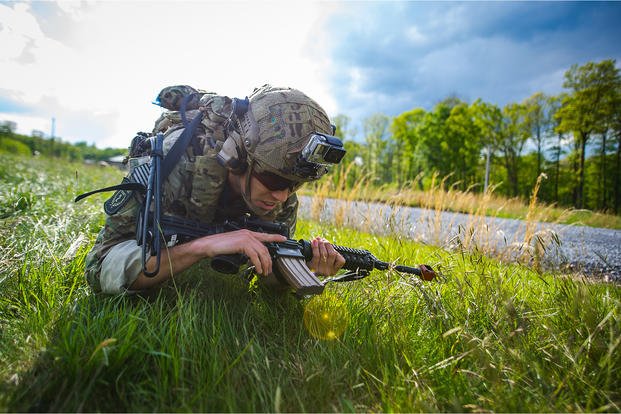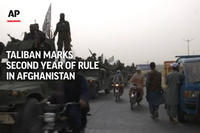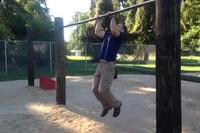They say Rangers lead the way, but how do you become a U.S. Army Ranger?
All Army Ranger candidates begin with nine weeks of basic combat training (BCT). If you are an Option 40x on your enlistment contract, your training will include BCT and advanced individual training (AIT) together in a 15-week course for the 11B/C infantry military occupational specialty known as one station unit training (OSUT).
After OSUT at Fort Benning, Georgia, you will go to the three-week Basic Airborne Course (BAC), then the Ranger Assessment and Selection Program (RASP).
After basic and AIT, your next step will be to complete airborne training. Airborne School is a unique experience requiring special dedication and a desire to be challenged mentally and physically. This three-week course, also known as Basic Airborne Training, teaches you the techniques involved in parachuting from airplanes and landing safely. The final test includes a non-assisted jump.
Airborne school is broken down into three weeks. The following explains the training you must complete during each week.
Ground Week: You start with an intensive program of instruction to build individual airborne skills. These skills prepare you to make a parachute jump and land safely. You will train on the mock door, the 34-foot tower and the lateral drift apparatus.
Tower Week: This completes your individual skill training and builds your team effort skills. To go forward to Jump Week, you must qualify on the swing lander trainer (SLT), master the mass exit procedures from the 34-foot tower and pass all physical training requirements.
Jump Week: During Jump Week, you must complete five jumps at 1,250 feet from a C-130 Hercules or C-141 Starlifter aircraft. If you successfully meet the course requirements, you will be granted an additional skill identifier and be authorized to wear the coveted "Silver Wing" on your uniform.
When you graduate from airborne school, you will attend the next class of RASP. The program is designed to determine whether you are suitable for service in the 75th Ranger Regiment.
The eight-week program consists of physical training and continuous preparation for service in the regiment. It is important that you learn the regiment's operational procedures, equipment and standards before your assignment.
RASP includes the following training:
- Daily physical training
- Ranger history test
- Map reading/land navigation (day/night)
- Airborne operation
- Ranger standards
- Five-mile run
- Combatives
- Knots
- Six-, eight- and 10-mile road marches
- Driver training (DDC Card)
- Fast-rope training
- Combat lifesaver certification
To pass RASP and qualify for the 75th Ranger Regiment, you must meet the following criteria:
- Score 60% on the Army Physical Fitness Test (APFT) in the 17-21 age group.
- Complete a five-mile run in less than eight minutes per mile.
- Successfully complete the combat water survival test (CWST). You must complete 15 meters in BDUs, boots and LBE.
- You must complete two of three road marches, one of which must be a 10-mile road march.
- You must score at least 70% on all exams.
Once you have completed RASP, you finally will be a Ranger and will receive an assignment either to the 75th Ranger Regiment Headquarters or one of the three Ranger Battalions.
Ranger School
After you have proven yourself at your Ranger Battalion, your next step will be to go to the Army's premiere leadership school -- Ranger School -- to earn your Ranger tab. This school is a requirement for officers as well as becoming a non-commissioned officer (NCO) in the Rangers. Not all troops who graduate Ranger School are assigned to a Ranger Battalion. In fact, the school regularly accepts some students from outside the Army.
Army Ranger NCOs are experts in leading soldiers on difficult missions. To do this, they need rigorous training. Over two months, Ranger students train to exhaustion, pushing the limits of their minds and bodies.
There are three distinct phases of Ranger School that require soldiers to make quick decisions in adverse situations. These phases are called "crawl," "walk" and "run."
Crawl (Darby) Phase: The Crawl Phase lasts 20 days. It's designed to assess and develop the necessary physical and mental skills to complete combat missions and the remainder of Ranger School successfully. If you are not in top physical condition when you report to the Ranger School, you will have extreme difficulty keeping up with the fast pace of Ranger training, especially during this first phase.
Walk (Mountain) Phase: The Walk Phase takes place in the mountains and lasts 21 days. During this phase, you will receive instruction on military mountaineering tasks, as well as techniques for employing squads and platoons for continuous combat patrol operations in a mountainous environment. You will further develop your ability to command and control a platoon-sized patrol through planning, preparing and executing a variety of combat patrol missions.
Run (Swamp) Phase: The Run Phase of Ranger School continues to develop your combat-arms functional skills. You must be capable of operating effectively under conditions of extreme mental and physical stress. This is accomplished through exercises in extended platoon-level patrol operations in a swamp environment. Run Phase training further develops your ability to lead small units on airborne, air assault, small boat, ship-to-shore and dismounted combat patrol operations in a low-intensity combat environment against a well-trained, sophisticated enemy.
Stew Smith is a former Navy SEAL and fitness author certified as a Strength and Conditioning Specialist (CSCS) with the National Strength and Conditioning Association. Send your fitness questions to stew@stewsmith.com.
Ready to Join the Military?
We can put you in touch with recruiters from the different military branches. Learn about the benefits of serving your country, paying for school, military career paths, and more: sign up now and hear from a recruiter near you.











